Bulb onions are incredibly profitable in Kenya, if you farm them right!
But you may ask yourself: How do I get started? What challenges should I be prepared to face? Is there enough market for all my produce? These are all valid questions for anyone considering venturing into onion farming in Kenya.
The good news is that with proper planning and execution, onion farming can be lucrative. Kenya’s diverse climate allows for year-round production, and the demand for onions in both local and export markets remains strong.
However, success in this field requires more than just planting and hoping for the best.
From selecting the right varieties for your region to mastering pest control techniques, there’s a lot to learn. But don’t worry – we’ve got you covered.
Read on…
Also Read: How to farm rosecoco beans in Kenya
Common Varieties of Bulb Onions
While Kenya’s diverse climate allows for the cultivation of various onion types, two varieties stand out as the most widely grown across the country: “Bombay Red” and “Red Creole”. These varieties have proven their adaptability to local conditions and market preferences. Let’s explore each in detail:
1. Red Creole
Red Creole is a favorite among Kenyan farmers for several reasons:
– Appearance: It produces attractive, flat-round to globular bulbs with a vibrant red color.
– Flavor Profile: Known for its intensely pungent taste, making it a popular choice for cooking.
– Growth Cycle: Reaches maturity in approximately 150 days after transplanting, allowing for careful harvest planning.
– Storage Quality: Excellent post-harvest longevity, which is crucial for market flexibility.
– Yield Potential: Impressively high, averaging around 16,000 kg per acre under optimal conditions.
2. Bombay Red:
This variety is particularly suited for specific growing conditions:
– Climate Adaptability: Thrives in drier and warmer regions of Kenya, making it a go-to choice for farmers in such areas.
– Bulb Characteristics: Produces small to medium-sized bulbs with a distinct globe shape and deep purple-red coloration.
– Flavor Intensity: Like Red Creole, it boasts a very pungent taste, appealing to those who prefer strong onion flavors.
– Maturity Period: Also reaches harvest readiness about 150 days after transplanting.
– Yield Potential: Matches Red Creole with an impressive 16,000 kg per acre under ideal growing conditions.
Here are other varieties and what you should know:
| Onion Species | Colour | Maturity (days) | Yield per Acre (tons) | Storage Period |
|---|---|---|---|---|
| Red Creole | Red | 150 | 16 | 5–6 months |
| Bombay Red | Purple Red | 150 | 16 | 5–6 months |
| Red Star F1 | Dark Red | 110-120 | 16 | 5 months |
| Neptune F1 | Red bulb | 110-120 | 16 | 5–6 months |
| Texas Grano | White | 120 | 21 | 5 |
| Tropicana F1 | Deep Red | 90-100 | 25 | 5 |
Optimal Growing Conditions for Bulb Onions in Kenya
Understanding the ideal ecological conditions for onion cultivation is crucial for achieving optimal yields. Let’s break down the key environmental factors:
| Requirement | Optimal Conditions |
|---|---|
| Altitude | 0 – 1,900 metres above sea level |
| Rainfall | 500 – 700 mm of rainfall annually |
| Growing Temperature | 15 – 30 °C |
| Soils |
• Fertile and well drained soil • pH range 6.0 – 6.8 |
1. Altitude:
Onions demonstrate remarkable adaptability, thriving at elevations up to 1,900 meters above sea level. This wide altitude range allows for cultivation in various regions across Kenya, from lowlands to highlands.
2. Rainfall:
Water requirements are specific and critical for onion development.
– Ideal rainfall: 500-700 mm throughout the growing period, evenly distributed.
– Timing is crucial: A dry spell is necessary as the onions approach maturity.
– Tip: In areas with unreliable rainfall, consider implementing irrigation systems to ensure consistent water supply.
3. Temperature:
Optimal growth occurs between 15°C and 30°C. Temperature sensitivity:
– Above 30°C: Accelerates maturity, resulting in smaller bulbs and reduced yields.
– Below optimal: Slows growth and may trigger premature flowering (bolting).
– Cold weather challenges: Increased susceptibility to leaf diseases.
– Recommendation: Choose varieties suited to your local temperature patterns and consider using protective structures in extreme conditions.
4. Soil Conditions:
By aligning your farming practices with these optimal conditions, you can significantly enhance the chances of a successful and profitable onion crop in Kenya.
– Soil type: Sandy to silty loams are ideal, offering good drainage and nutrient retention.
– Fertility: Onions thrive in fertile soils rich in organic matter.
– Drainage: Well-drained soils are essential to prevent waterlogging and associated root diseases.
– pH level: Optimum range is 6.0 to 6.8.
– Below 6.0: Consider liming to increase pH.
– Above 6.8: Certain nutrients may become less available.
– Soil structure: Fine tilth (well-broken, crumbly soil) is crucial for proper bulb formation.
Understanding these ecological requirements allows farmers to:
1. Select the most suitable regions for onion cultivation.
2. Time planting to coincide with optimal growing conditions.
3. Implement necessary soil amendments or irrigation systems.
4. Choose appropriate varieties for specific microclimates.
Crop Planting Calendar for Farmers
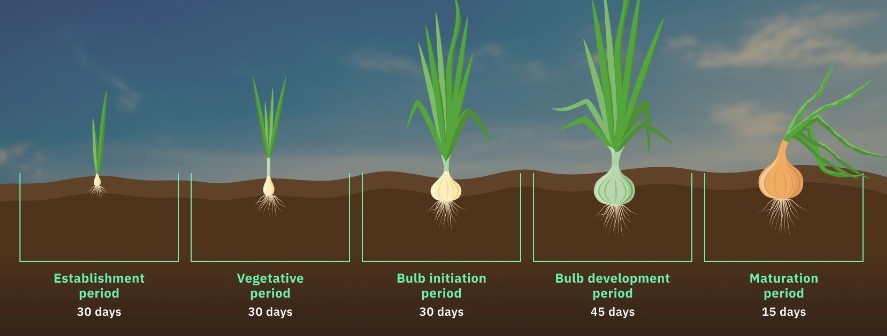
Source/Credit: EOS Data Analytics
A Crop Planting Calendar is an essential planning tool for bulb onion farmers in Kenya. It helps align production schedules with market demands, potentially maximizing profits by ensuring harvest coincides with peak market prices.
Here’s how to create your calendar:
1. Market Research
Conduct or refer to market surveys to identify peak demand periods for bulb onions.
Note: In Kenya, demand often peaks during major holidays or dry seasons when fresh produce is scarce.
2. Backward Planning
Once you’ve identified the target harvest month, work backwards to create a monthly schedule of farming activities. Consider the growth cycle of your chosen onion variety (typically 150 days for common Kenyan varieties).
3. Detailed Activity Plan
Break down each month into specific tasks, such as:
– Soil preparation
– Seedling production or procurement
– Transplanting
– Fertilization schedule
– Pest and disease management
– Irrigation planning
– Harvesting and post-harvest handling
How to Plant Bulb Onions
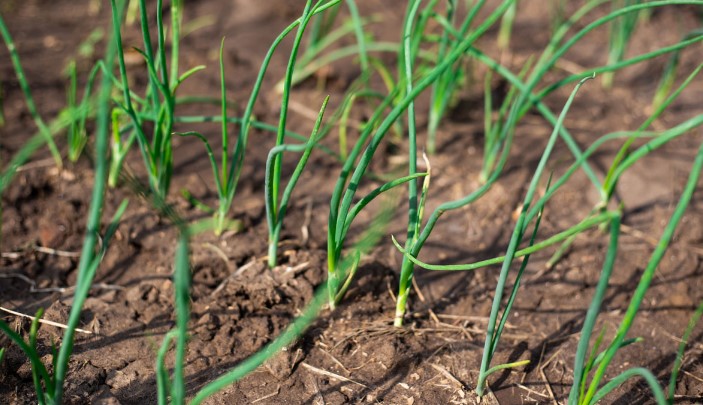
Planting bulb onions successfully requires careful preparation and attention to detail. Whether you’re a seasoned farmer or a beginner, understanding the proper techniques can significantly impact your crop’s yield and quality.
Bulb onions can be grown from seeds, sets (small bulbs), or transplants, each method with its own advantages. The choice often depends on your climate, available resources, and desired harvest time.
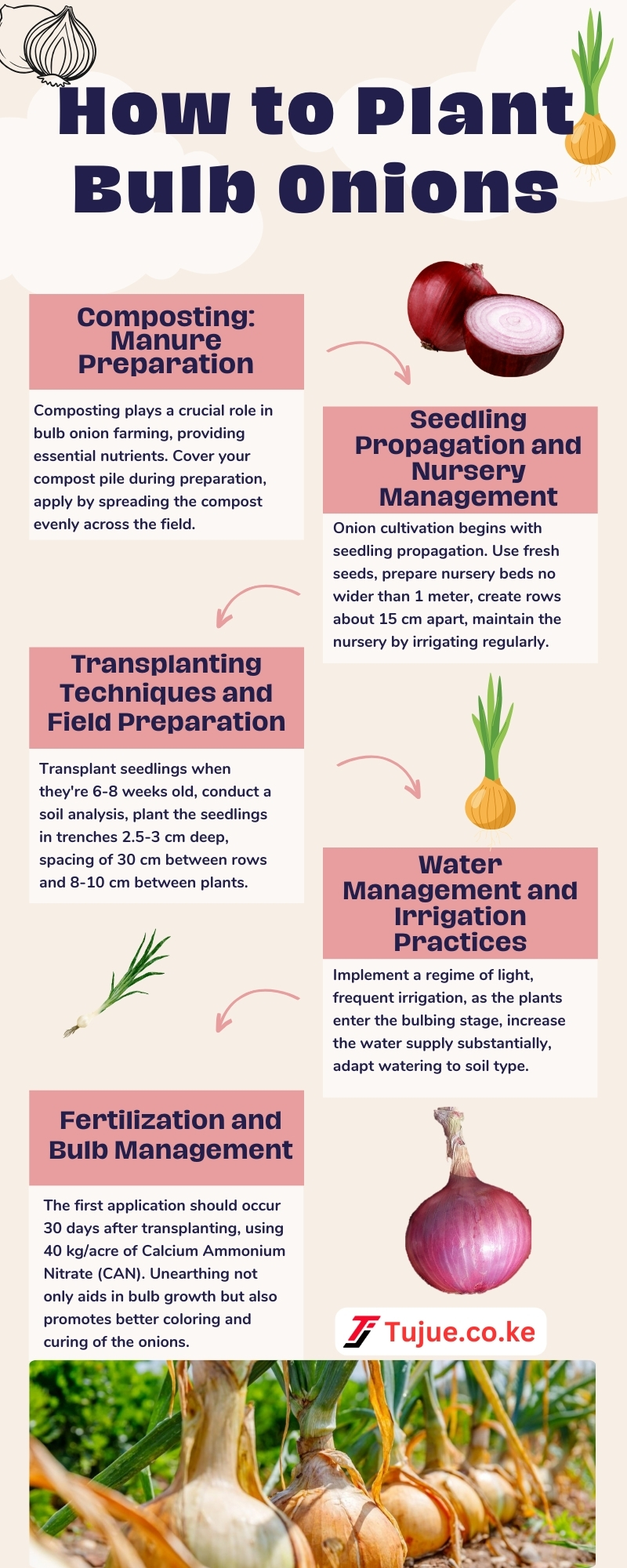
How to Plant Bulb Onions Infographic
1. Composting: Manure Preparation
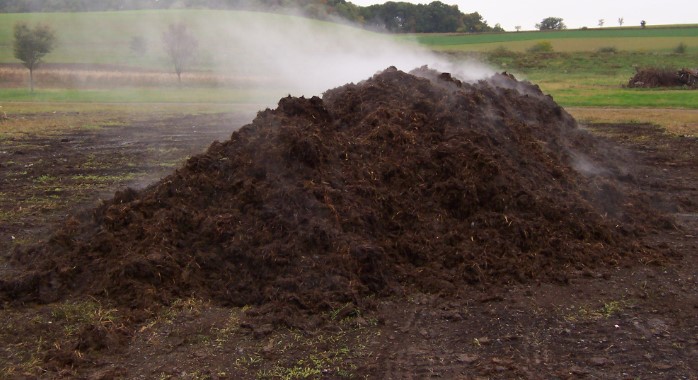
Composting plays a crucial role in bulb onion farming, providing essential nutrients and improving soil structure. Here’s what you need to know:
– Cover your compost pile during preparation to prevent nutrient leaching.
– This protection is especially important during rainy periods.
– These crops thrive in soils rich in organic matter, making compost an ideal supplement.
– The recommended compost application for bulb onions ranges from 10 to 16 tons per acre.
– This generous application rate reflects the crop’s high nutrient demands.
– Ideally, incorporate compost into the soil several weeks before planting.
– This allows time for the compost to integrate with the soil and begin releasing nutrients.
Application Method:
– Spread the compost evenly across the field.
– Incorporate it into the top 6-8 inches of soil through tilling or plowing.
Apply aged manure or compost to the soil 7-14 days before planting bulb onions. This organic matter greatly benefits onion growth.
2. Seedling Propagation and Nursery Management
Onion cultivation begins with seedling propagation. Here are good pointers to consider:
– Use fresh seeds at a rate of 0.8-1.2 kg per acre, sowing them in a nursery under mulch cover.
– Prepare nursery beds no wider than 1 meter, incorporating 20 kg/m2 of well-decomposed compost or farmyard manure, along with 20 g/m2 of DAP or TSP.
– Create rows about 15 cm apart, sowing seeds thinly in 1 cm deep furrows.
– Cover lightly with soil and mulch. Expect germination within 7-10 days. Once seeds emerge, remove the mulch and prepare a raised cover.
– Maintain the nursery by irrigating regularly and managing weeds, pests, and diseases as necessary. This careful nursery management ensures healthy seedlings for transplanting.
3. Transplanting Techniques and Field Preparation
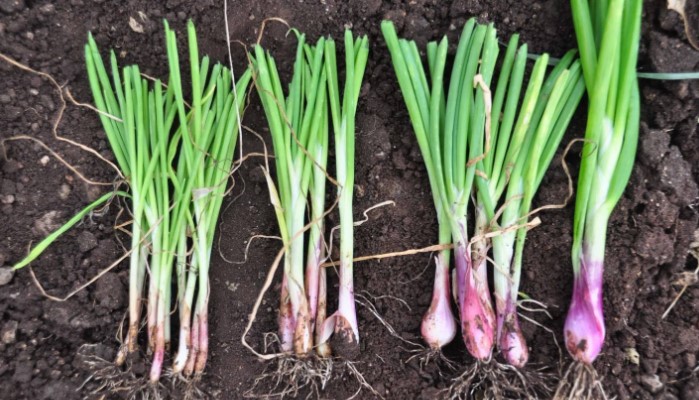
Here are some good pointers for transplanting:
– Transplant seedlings when they’re 6-8 weeks old, or have developed 3-5 well-formed leaves and a pencil-thick base.
– Before transplanting, conduct a soil analysis to determine specific nutrient requirements. Apply 80 kg/acre of TSP to the field and irrigate thoroughly a day before transplanting.
– When removing seedlings from the nursery, do so carefully to prevent damage. Trim 50% of the green tops to promote faster establishment.
– Plant the seedlings in trenches 2.5-3 cm deep, maintaining a spacing of 30 cm between rows and 8-10 cm between plants when using furrow irrigation.
Note: If planting onion sets instead of seedlings, ensure they’re not buried more than one inch deep. This precise transplanting method gives the young onions the best start in their new environment.
4. Water Management and Irrigation Practices
Proper water management is crucial for successful onion cultivation. Here’s what to consider:
– Implement a regime of light, frequent irrigation, being careful to avoid excessive moisture during the initial growing stage.
– As the plants enter the bulbing stage, increase the water supply substantially. Towards bulb maturity, reduce or discontinue watering to promote proper development.
– Adapt your watering strategy to soil type – lighter soils need more frequent but less intense watering. As plants and roots increase in size, gradually increase the amount of water applied. This careful moisture management is vital for preventing issues like pink root disease, maintaining overall root health, and encouraging vigorous bulb growth.
Note: Be aware that drought stress can result in splitting or the formation of double or multiple bulbs, compromising crop quality and yield.
5. Fertilization and Bulb Management
This stage involves a few steps:
Top-dressing:
Prior to planting, conduct a soil analysis to determine specific nutrient requirements. Implement top-dressing in two stages for optimal onion growth.
The first application should occur 30 days after transplanting, using 40 kg/acre of Calcium Ammonium Nitrate (CAN). Follow this with a second application 45 days after transplanting, increasing the amount to 80 kg/acre of CAN.
For more efficient nutrient uptake, employ the strip or banding method rather than broadcasting. Be cautious with nitrogen application, as excessive amounts can lead to thick necks in onions. It’s crucial to complete all top-dressing before the bulbing process begins to ensure proper development.
Unearthing:
Unearthing is a critical practice in onion cultivation that involves removing excess soil around the bulb or loosening the soil to facilitate bulb expansion and proper development.
This process not only aids in bulb growth but also promotes better coloring and curing of the onions. If the soil becomes compacted during the bulb formation stage, it’s essential to loosen it, allowing the bulbs to develop fully.
Typically, unearthing is performed during the second and subsequent weeding sessions. The process involves carefully removing soil from around the bulbs by hand.
However, exercise caution during this procedure to avoid damaging or exposing the roots, which could negatively impact the plant’s health and yield.
Pest Management in Bulb Onion Cultivation
Pest infestations can significantly reduce both the quality and quantity of onion yields. In Kenya, two primary pests pose substantial threats to bulb onion crops: Onion Thrips and Onion Flies.
Understanding these pests and implementing effective control measures is crucial for successful onion cultivation.
1. Onion Thrips
Onion thrips are minute insects, measuring between 0.5 to 2.0 mm in length. Adults have a slender body and are winged, with their wings characterized by a long, narrow shape fringed with elongated hairs.
The nymphs are easily distinguishable by their white or yellow coloration. Both adult thrips and nymphs tend to feed at the base of the plant, nestled within the leaf sheaths.
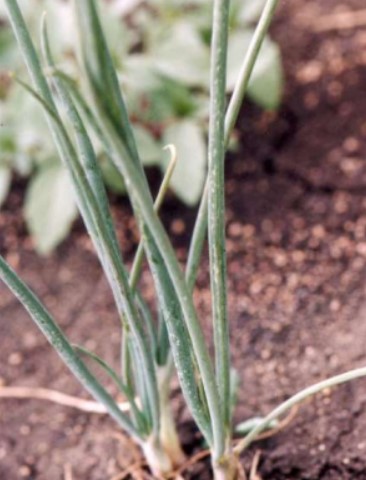
Damages:
The feeding activity of thrips results in distinctive damage patterns on onion leaves. Affected leaves develop sunken, silvery patches. In cases of severe infestation, the entire plant may take on a silvery appearance.
As the infestation progresses, leaves begin to wither, dry up, and eventually die. A telltale sign of thrips presence is their excreta, which appears as black spots on the silvery leaves.
Control:
To manage onion thrips effectively, implement the following strategies:
1. Maintain adequate irrigation, as water-stressed plants are more susceptible to thrips damage.
2. Keep plots weed-free to reduce alternative hosts for thrips.
3. Remove and destroy heavily infested plants to prevent spread.
4. Apply neem extracts as a natural pesticide on affected plants.
5. When necessary, use approved insecticides such as Spinosad (Tracer®), Abamectin + Acetamiprid (AMAZING TOP 100 WDG®, with a Pre-Harvest Interval of 21 days), or Acephate (ASATAF SP®, with a Pre-Harvest Interval of 3-7 days).
2. Onion Flies
The most destructive stage of the onion fly is its larval form, known as maggots. These maggots are cream-white in color and measure approximately 8 mm in length.
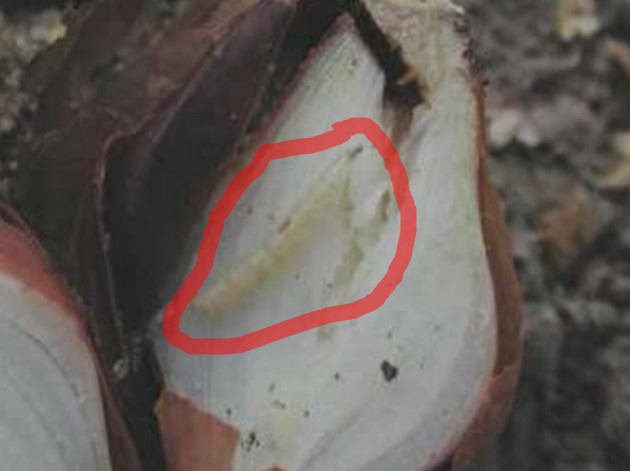
Damages:
Onion fly maggots cause severe damage by feeding on the lateral roots of onion plants. They create tunnels into the taproot, leading to plant shriveling and eventual death.
Additionally, these pests can be found inside developing onion bulbs, where their feeding activity exposes the plant to secondary infections, particularly Bacterial Soft Rot.
Control:
To effectively manage onion fly infestations:
1. Implement crop rotation to break the pest’s life cycle.
2. Use well-decomposed manure or compost to improve soil health and plant resilience.
3. Practice strict field sanitation by promptly removing and destroying infested plants.
4. After harvest, carefully plough in crop residues to eliminate potential overwintering sites for the pest.
Major Diseases in Bulb Onion Farming
Disease infections can significantly reduce both the quality and quantity of onion yields. In Kenya, five primary diseases pose substantial threats to bulb onion crops: Onion Downy Mildew, Purple Blotch, Rust, Pink Root, and Neck Rot.
Understanding these diseases and implementing effective control measures is crucial for successful onion cultivation.
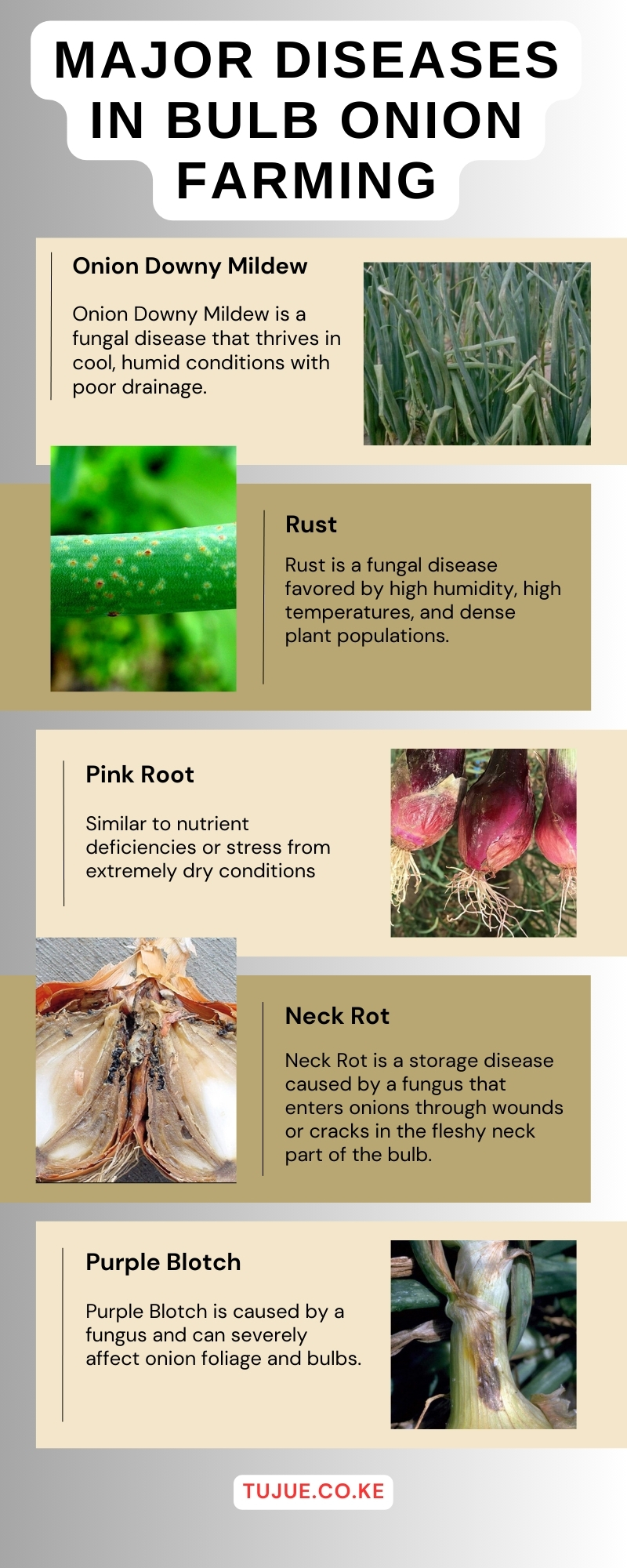
Major Diseases in Bulb Onion Farming Infographic
1. Onion Downy Mildew
Onion Downy Mildew is a fungal disease that thrives in cool, humid conditions with poor drainage.
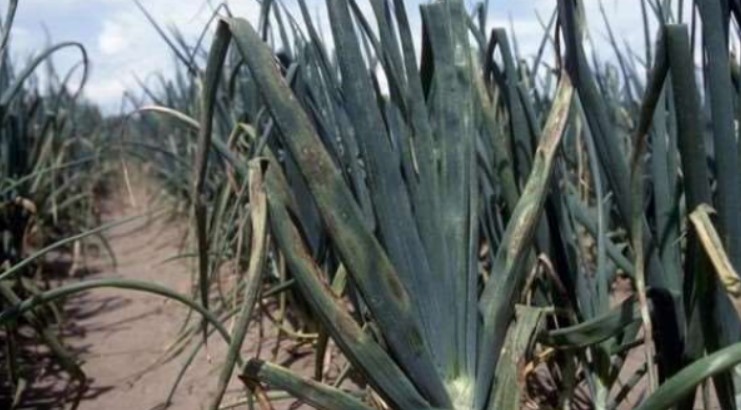
Symptoms:
• Lesions form near the tips of older leaves
• Yellow patches covered with grey, wet areas appear
• Leaf tips shrink, turn pale brown, and eventually die
Control:
• Maintain proper field hygiene
• Implement crop rotation
• Use tolerant varieties like Red Pinoy F1
• Apply fungicides such as Mancozeb (Cadilac®, Dithane M45®)
2. Purple Blotch
Purple Blotch is caused by a fungus and can severely affect onion foliage and bulbs.
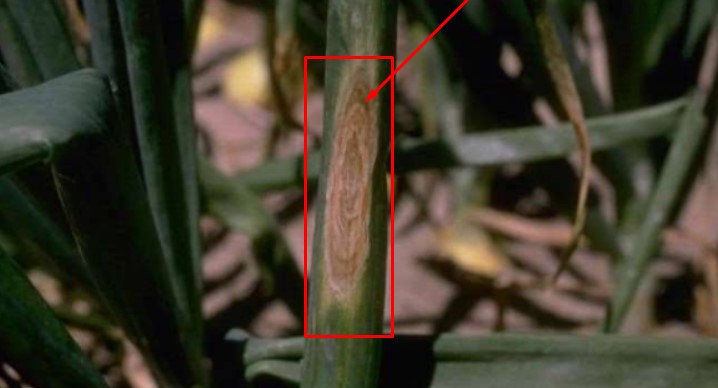
Symptoms:
• Small white spots initially appear on foliage
• In moist conditions, spots expand to large purplish blotches with yellow-orange borders
• Lesions may girdle leaves, causing collapse
• Infection can spread to bulbs, causing wet, orange rot starting at the neck
Control:
• Use resistant varieties like Red Passion F1 and Red Pinoy F1
• Practice crop rotation and field sanitation
• Avoid over-fertilization
• Maintain recommended spacing and good drainage
• Apply fungicides such as Mancozeb, Difenoconazole, Propineb + Cymoxanil, or Eugenol
3. Rust
Rust is a fungal disease favored by high humidity, high temperatures, and dense plant populations.
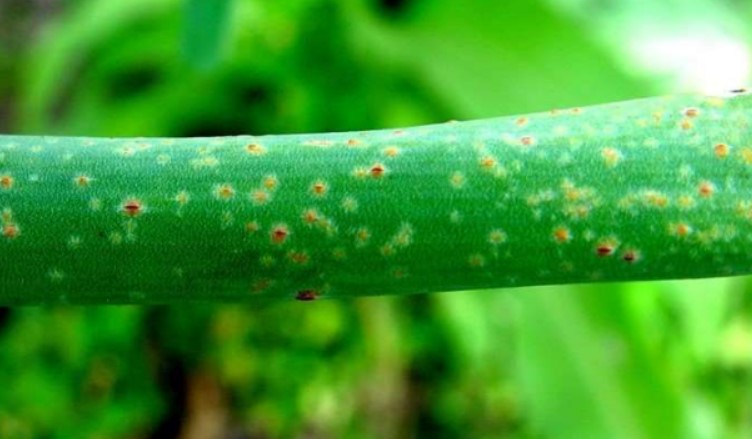
Symptoms:
• Small reddish dusty spots (pustules) appear on leaves
• Heavily infected leaves turn yellow and die prematurely
Control:
• Implement crop rotation
• Apply proper agronomic practices, including nutrition and spacing
• Use fungicides like Mancozeb, Difenoconazole, or Eugenol
4. Pink Root
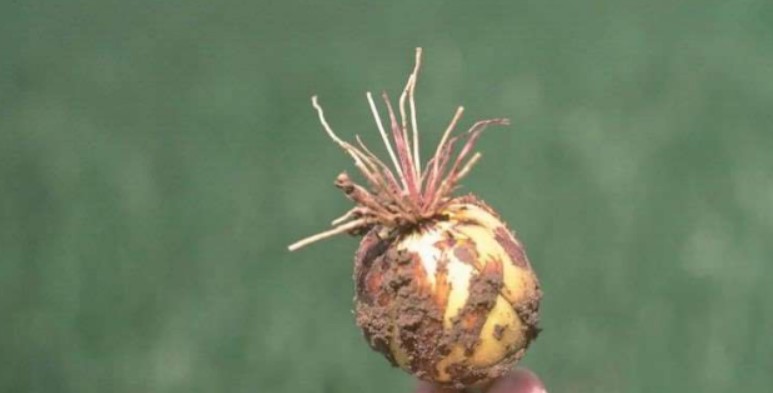
Symptoms:
• Similar to nutrient deficiencies or stress from extremely dry conditions
• Light pink to yellowish-brown discoloration on roots, progressing to dark pink, red, and purple
• In advanced stages, roots shrivel, become brittle, and die
Control:
• Implement good management practices to reduce plant stress
• Practice crop rotation
• Use tolerant cultivars like Red Passion F1
5. Neck Rot
Neck Rot is a storage disease caused by a fungus that enters onions through wounds or cracks in the fleshy neck part of the bulb.
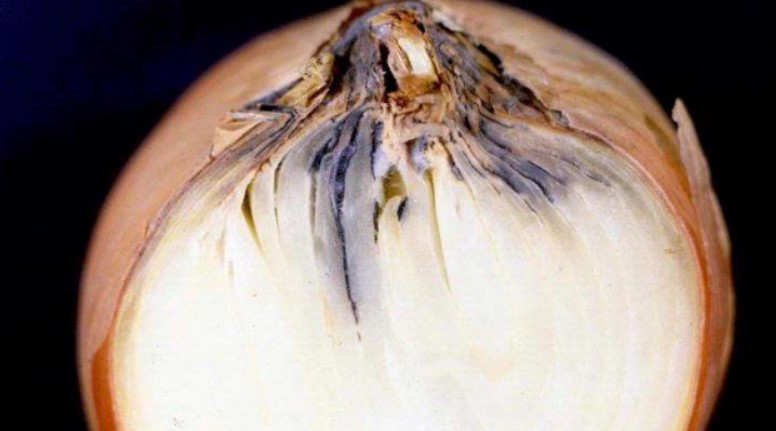
Symptoms:
• Top part of the bulb turns browner with darker brown skin
• Upper portion of the bulb becomes softer than lower parts
• Grey mold with small black spots appears, leading to further deterioration
Control:
• Use fungicide-treated seeds or sets
• Avoid damaging bulbs during harvest
• Allow foliage to dry naturally; don’t bend over to hasten drying
• Harvest only when necks have naturally ripened and fallen
• Limit use of high nitrogen fertilizers
• Practice crop rotation (at least 3 years)
• Thoroughly dry bulbs after harvest, prioritizing good ventilation over sun exposure
• Store only bulbs with dried, thin necks in cool, dry places
• Regularly inspect and remove any bulbs showing signs of rot
Harvesting Bulb Onions
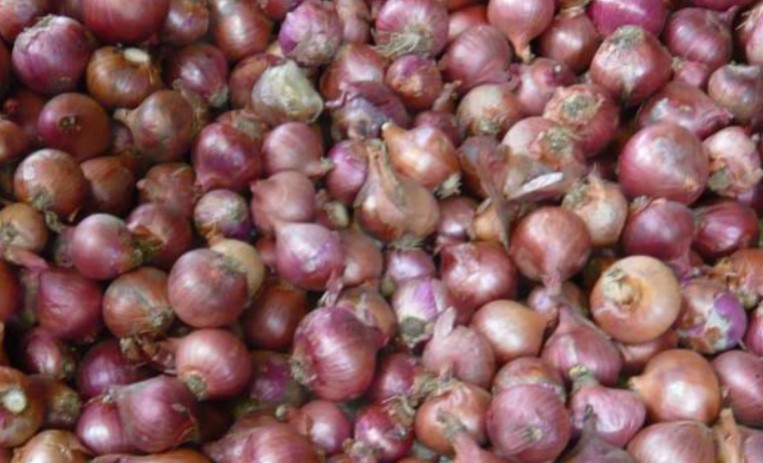
Bulb onions typically reach maturity 90 to 150 days after transplanting, depending on the variety. Harvest readiness is indicated when 75% of the crop’s tops have dried and fallen over.
Key signs include:
• Leaf tops beginning to discolor, bend, and dry towards the ground
• Reduced thickness of sheath leaves surrounding the bulbs, resulting in a papery membranous cover
Here are important phases to keep in mind:
1. Curing
Curing is a crucial post-harvest process designed to dry off the necks and outer leaves of onion bulbs. The primary objective is to extend shelf life by preventing moisture loss and reducing susceptibility to diseases.
Curing can be performed either in the field or in a protected environment, depending on weather conditions.
Field Curing:
• Ideal when maturity and harvesting coincide with dry months
• Harvested onions are arranged in rows with leaves partially covering the bulbs to prevent sunburn or greening
• Onions remain in the field until outer leaves and necks are completely dry and papery
• The process typically takes 2-3 weeks, depending on environmental conditions
Protected Curing:
Conducted in a warm, dry, well-ventilated location, protected from direct sunlight and rain. Process involves:
– Removing excess soil
– Trimming foliage, leaving 2.5cm of stem at the neck
– Placing onions in a single layer on large flat trays
– Alternatively, onions can be cured by tying bulb tops in bunches and hanging on horizontal poles in well-ventilated shade
2. Sorting and Grading
Before storage, remove the following:
• Onions with thick necks
• Onions that have bolted
• Injured onions
• Decayed onions
• Doubles and small bulbs
Grading:
• Should be performed before and after storage
• For domestic markets, onions are typically categorized into three grades: large, medium, and small
• Quality requirements for all grades:
– Intact with firm flesh that is not exposed
– Clean and free from visible foreign matter
– Sufficiently dry with the first two outer skins and stem fully dry
– Free from abnormal external moisture
– Free from foul smell
Containers & Packaging Materials:
Store and package bulb onions in well-ventilated containers, such as onion nets
What is the Best Time to Plant Onions in Kenya?
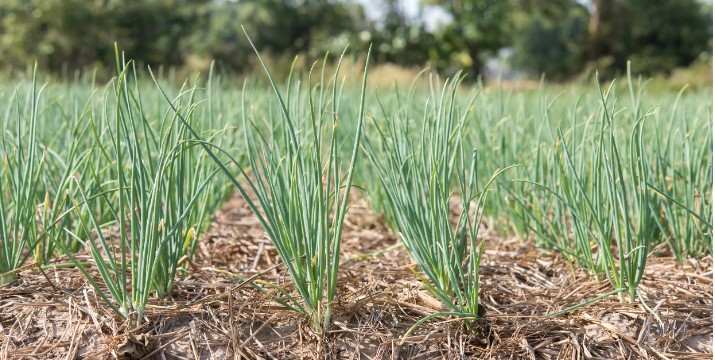
Timing is crucial in onion farming, and in Kenya, it can make the difference between a profitable harvest and a loss. The ideal planting times are influenced by several factors:
1. Market Demand Cycles
Peak demand typically occurs from late April through June.
There’s often a supply shortage starting in late April, leading to higher prices.
2. Seasonal Planting Guide
August Planting: Start nurseries in August for a December-January harvest. This timing often coincides with high demand and good prices.
December Planting: Plant another crop in December for a May-June harvest. Prices during this period can range from 55 to 90 Kenyan shillings per kilogram.
3. Market Fluctuations
Late January to Early March: Surplus from Nyeri region floods the market. Prices are average, around 50-55 shillings per kilogram, but still allow farmers to break even.
July and August: Tanzanian imports often saturate the market, causing prices to drop significantly.
4. Import Dynamics
To meet demand, Kenya imports onions from Ethiopia, Egypt, and India, especially during shortage periods.
5. Production Strategies
– Consider staggered planting to have harvests at different times of the year.
– Aim for a constant supply to stabilize prices and reduce reliance on imports.
6. Yield Optimization
– With good farming practices, yields of 15-20 tonnes per acre are achievable.
– Even at lower prices (around 40 shillings per kg), these yields can ensure profitability.
Where is the Best Place to Plant Onions in Kenya?
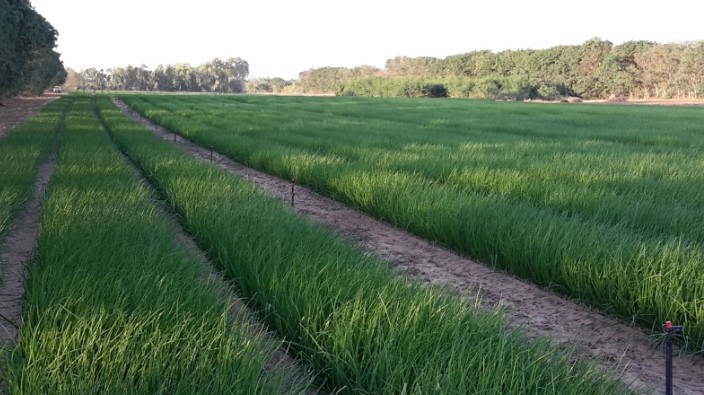
The success of onion farming in Kenya largely depends on choosing the right location. Here’s a detailed look at the best areas and why they’re suitable:
1. Top Regions for Onion Farming:
– Karatina
– Oloitoktok
– Machakos
– Makueni
– Naivasha
– Kieni
– Emali
– Meru
– Kajiado
– Mai Mahiu
2. Factors Making These Regions Suitable:
– Climate: These areas generally have moderate temperatures and adequate rainfall or irrigation facilities.
– Soil Type: Well-draining, fertile soils rich in organic matter.
– Altitude: Most of these regions are at medium to high altitudes, which are ideal for onion cultivation.
Bulb Onion Yield Per Acre: How Much can One Earn?
Is bulb onions farming in Kenya profitable? Simple answer – Yes!
The profitability of onion farming in Kenya can be significant, but it varies based on several factors.
Here’s a detailed breakdown:
1. Potential Yield
– Average Yield: About 16 tons per acre in a good season.
– High-End Yield: Up to 20 tons per acre with optimal conditions and farming practices.
2. Price Variations
– Average Price: 60 Kenyan shillings per kilogram.
– Price Range: Can fluctuate between 40 to 90 shillings per kilogram depending on the season and market conditions.
3. Gross Revenue Calculations
– At Average Yield and Price: 16 tons × 60 KES/kg = 960,000 KES per acre.
– At Peak Prices: 16 tons × 90 KES/kg = 1,440,000 KES per acre.
– At Low Prices: 16 tons × 40 KES/kg = 640,000 KES per acre.
4. Factors Affecting Profitability
– Production Costs: Include seeds, fertilizers, pesticides, labor, and irrigation.
– Market Access: Transportation costs and ability to reach high-paying markets.
– Storage Capabilities: Ability to store onions to sell when prices are higher.
– Farming Expertise: Better farming practices lead to higher yields and quality.
5. Break-Even Analysis
– Farmers can break even with yields of 15-20 tons per acre, even at lower prices of around 40 KES per kg.
Happy Planting and a Bumper Harvest
Bulb onion farming in Kenya presents a lucrative opportunity for farmers who approach it strategically. Success in this sector hinges on three key factors: optimal timing of planting and harvesting, selection of suitable growing locations, and implementation of effective farming practices.
While potential earnings can be significant, with yields of up to 16 tons per acre translating to around 960,000 KES at average prices, farmers must navigate challenges such as market fluctuations and production costs. As the country works towards achieving year-round local production, the sector offers room for growth and innovation, making it an attractive option for both new and experienced farmers.

